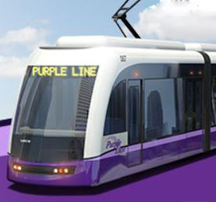Urban Road Code Amendments
Montgomery County's urban areas are growing, but their wide, fast streets, designed to prioritize drivers over everyone else, are holding them back.
Bill 33-13 before the Montgomery County Council will unshackle our downtown areas as well as letting our emerging ones blossom to their true potential. The bill supports our county and state’s explicit Smart Growth policies while further enhancing our environmental and economic health.
Bill 33-13 is an update of the county's Road Code, which was approved in 2008 as an attempt to create “complete” streets that accommodate pedestrians and cyclists in addition to drivers. To offer recommendations, County Executive Ike Leggett convened a 24-member task force, including representatives from groups like the Coalition for Smarter Growth and the Washington Area Bicyclist Association, as well as AAA. Many of the bill's progressive features fell by the wayside due to AAA pressure to allow wider roads and remove street trees, which spokesperson Lon Anderson called a hazard to drivers.
Bill 33-13 will help the Road Code fulfill its original purpose. Whether in emerging walkable urban places like Wheaton or already celebrated traditional walkable urban downtowns like Bethesda and Silver Spring that were built before cars became common, wide, fast streets are unpleasant to walk on at best, and at worst, a danger to pedestrians. This bill will make those streets safer by slowing traffic and forcing drivers to pay attention.
Opponents of this bill will complain about features such as smaller turning radii and ten foot wide lanes. They will try to pretend that the status quo doesn’t really encourage drivers to speed around too-wide corners at 30 miles per hour into a lane that is as wide as those on an interstate highway. Curbs with smaller turning radii force drivers to slow down and look for pedestrians in the crosswalk while also decreasing the length of the crosswalk for pedestrians, making it safer and more convenient to cross the street.
Drivers drive as fast as they perceive road conditions will allow. They slow down on Connecticut Avenue south of East-West Highway because safe driving on the narrow lanes there requires more care and attention. The speed cameras on Connecticut Avenue record instances where a driver doesn’t take heed of the road conditions. Meanwhile, drivers continue to speed on 16th Street between East-West Highway and Georgia Avenue because of the interstate-width lanes. The speed cameras there record drivers who do respond to road conditions. Our downtown areas need downtown streets, not interstate highways.
Further, many streets in economically vibrant walkable urban sections of the neighboring District of Columbia such as Woodley Park have narrower lanes and smaller turning radii. There is no evidence of unreasonable difficulty or any complaint from delivery vehicles about fulfilling orders. Durable goods and foodservice outlets are comparably well stocked as in Montgomery County.
The Action Committee for Transit believes that Bill 33-13 requires strengthening in order to fully meet its objectives. We reiterate our position in our Safe Walk to Schools Campaign that the maximum width on travel lanes near schools, regardless of the road type, should be ten feet. We also believe that the Montgomery County Department of Transportation should not be allowed to use sidewalk construction as an excuse for lane widening. The road code should specify that when sidewalks or other pedestrian improvements are built, lanes must remain at their existing width or be narrowed.
Complete streets are also better for the county's economy. More people want to live in our walkable downtown communities but many opt to live in neighborhoods in the neighboring District of Columbia where the main streets are better oriented towards pedestrians without the wide lanes and high speeds. More residents moving into our walkable urban downtown areas creates an increasing tax base without putting any pressure on or encroaching on our valuable Agricultural Reserve.
Multiple surveys that say that Millennials, and the next generation behind them, prefer living in healthy pedestrian-oriented urban areas. More importantly, there are also many years of real dollars spent that say the same thing. Montgomery County has been in competition with neighbors in the District of Columbia and Arlington County, Virginia for these younger professionals, their tax dollars, and their longer-term settlement patterns for years.
New downtown areas in neighboring Prince George’s County, Fairfax County, Virginia, as well as more newly revitalized areas of the District of Columbia will provide further competition for the large numbers of new residents anticipated in the Region's job forecasts. Our county simply can’t afford to handicap its downtown areas through inappropriate infrastructure codes. It would threaten our future economic vitality.
Streets that are nicer to walk or bike along mean more foot traffic plus more customers for local shops and restaurants. Studies show that pedestrians and cyclists spend as much if not more at businesses than drivers do in downtown areas. That's especially good news for the county's Nighttime Economy Initiative, which seeks to encourage nightlife in its urban areas.

